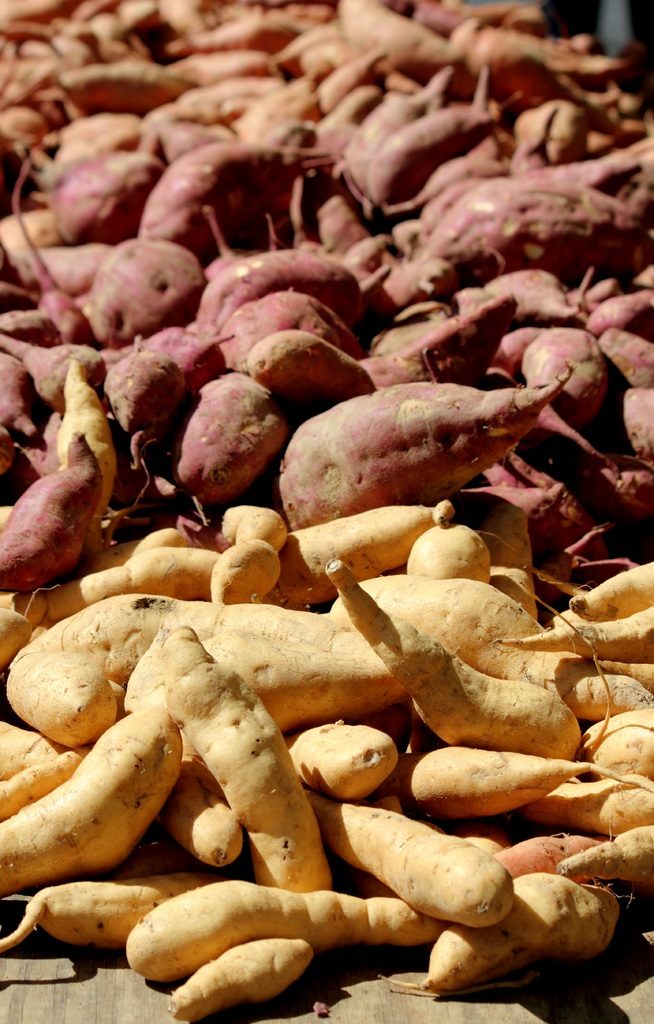[Article updated on 19/09/2023]
A food of exceptional richness, the sweet potato is followers among supporters of a healthy and balanced diet. Onne counts more nutritionists and dietitians who recommend it to their patients and it now replaces many starchy foods in diets slimming. However, a question arises: is the sweet potato a starchy food or a vegetable?
What is sweet potato?
Sweet potato (Ipomoea batatas) is a dicotyledonous plant belonging to the bindweed family, namely Convolvulaceae. Its large, starchy, sweet-tasting tuberous roots are a root vegetable. Young leaves and shoots are sometimes eaten green. The sweet potato is only a distant cousin of the potato (Solanum tuberosum) and does not belong to the nightshade family. However, both families belong to the same taxonomic order, namely Solanales.

The sweet potato is a perennial herbaceous vine, bearing alternate heart-shaped or palmate leaves, as well as sympetalous flowers medium sized. The edible tuberous root is long and tapered, with smooth skin colored yellow, orange, red, brown, purple and beige. Her flesh varies from beige to white, including red, pink, purple, yellow, orange and purple. Sweet potato cultivars with white flesh or pale yellow are less sweet than those with red, pink or orange flesh.
Ipomoea batatas is native to tropical regions of America. In this family which has approximately 50 genera, the sweet potato is the only cultivated plant of major importance. Some like Ipomoea aquatica (kangkong) are used locally, but many are toxic. Genre Ipomoea, which contains the sweet potato, also includes several garden flowers. Some cultivars ofIpomoea batatas are grown as ornamental plants.
Sweet potato is sometimes called “yam” in parts of North America, but it is very distinct from the point of view botanical view of yams.
Nutritional value of potatoes
A raw sweet potato contains water (75%), carbohydrates (20.1%), proteins (1.6%), fibers (3%) and almost no materials fatty.
Carbohydrates
One medium-sized sweet potato, boiled without skin, contains 27 grams of carbohydrates. The main components are carbohydrates complexes called starches, which represent 53% of the carbohydrate content. THE simple sugars, such as glucose, fructose, sucrose and maltose, constitute 32% of the carbohydrate content.
The glycemic index is a measure of how quickly in which blood sugar increases after a meal. Sweet potatoes have an index finger medium to high glycemic index, varying from 44 to 96. Considering the index relatively high glycemic of sweet potatoes, large quantities in a single meal may not be suitable for diabetics.
Boiling appears to be associated with index values blood sugar levels lower than those of baking, frying or roasting.
Fibers
Cooked sweet potatoes are relatively rich in fiber. One medium-sized sweet potato contains 3.8 grams of fiber. These fibers are both soluble (15-23%) in the form of pectin and insoluble (77-85%) in the form of cellulose, hemicellulose and lignin.
Soluble fiber, such as pectin, can increase satiety, decrease food intake and reduce spikes in blood sugar, while slowing the digestion of sugars and starchy foods. Insoluble fiber has been linked to benefits for health, such as a reduction in the risk of diabetes and an improvement in gut health.
Proteins
A medium-sized sweet potato contains 2 grams of protein, which is relatively low. However, this food contains unique proteins, called sporamins, which represent more than 80% of total proteins. Sporamins are produced each time the plant is subjected to physical stress. They facilitate healing.
Recent research suggests that these proteins could have antioxidant properties. However, although they are relatively poor in protein, sweet potatoes are a source of important protein in many developing countries.
Vitamins
Sweet potatoes are rich in several vitamins and minerals and are an excellent source of beta-carotene, vitamin C and potassium. Among the most abundant vitamins and minerals in sweet potatoes, we find:
- vitamin A: Sweet potatoes are rich in beta-carotene, which converts to vitamin A in the body. The recommended daily amount of vitamin A can be achieved with just 100 grams of sweet potatoes.
- vitamin C: it is an antioxidant that can reduce the duration of colds and improve skin health.
- potassium: Important for blood pressure control, this mineral may reduce the risk of heart disease.
- manganese: this trace element is important for growth, development and metabolism.
- vitamin B6: it plays an important role in the conversion of food into energy.
- pantothenic acid or vitamin B5 : This vitamin is found to some extent in almost all foods.
- vitamin E: It is a powerful fat-soluble antioxidant that can help protect the body against oxidative damage.

Sweet potato: a superfood?
Undeniable nutritional benefits
Sweet potatoes are a rich source of fiber and contain an array of vitamins and minerals including iron, calcium and selenium. They are a good source of most vitamins B and C. One of the main nutritional benefits of this food is a group of antioxidants called beta-carotenes. They transform into vitamin A once consumed. Adding a drizzle of olive oil just before serving can increase the absorption of beta-carotenes.
Health claims or proven benefits?
With their exceptional nutrient richness and sweet taste, sweet potatoes are one of the most versatile and healthiest foods available. They are full of benefits against various diseases and can strengthen the immune system. These tubers are also good sources of anti-inflammatory nutrients, like vitamins A and C.
This makes it a great food choice for people with arthritis or asthma. People with diabetes can also benefit from consuming this root vegetable, as it does not have a very high glycemic index and has a lesser effect on blood sugar levels.
Although there are no “superfoods” that can prevent cancer and some cancer risk factors are independent of diet, there is evidence that a healthy diet can reduce cancer risk. Fruits and vegetables are rich in antioxidants, compounds that help the body defend against damage caused by “free radicals.”
Studies have suggested that antioxidants found in the skin of sweet potatoes, and particularly purple sweet potatoes, may help reduce this oxidation process, thereby reducing the risk of cancer. To get the most nutrition from your sweet potatoes, don’t peel them. Simply wash them well before cooking. A study from Asia also found that diets rich in vitamin A could provide potential protection against lung cancer.

The Truth About Sweet Potato Grading
Is sweet potato a starchy food like potato?
Potatoes have fallen out of favor in recent years, with health authorities saying starchy foods should not be considered unhealthy. vegetables in the diet. The USDA recently proposed reducing the amount of potatoes served in school cafeterias.
But this attack on potatoes leaves some confusion: should sweet potatoes and other tubers and roots also be classified in this category?
A very good starch, with high nutritional content
Linda Antinoro, a dietitian at Brigham and Women’s Hospital, says that when she evaluates meals, she and her colleagues consider potato and sweet potato to be starchy foods. Just like white potatoes, sweet potatoes contain a high amount of starch, an abundant carbohydrate found in all kinds of plants. A serving of sweet potato contains about triple the number of calories of a similar volume of carrot or other vegetable.
However, they encourage people to eat a sweet potato rather than other starchy foods. By replacing potatoes, rice, pasta or bread with a sweet potato, you add a huge dose of beta-carotene, as well as vitamin C, potassium and other vitamins and minerals to your diet.
If you eat sweet potatoes with their skins on, you also get plenty of fiber, which can help prevent blood sugar from spiking after the meal. It can also discourage overeating by giving a feeling of fullness. The American Diabetes Association has listed sweet potatoes as one of 10 “super foods” that are high in nutritional content and don’t cause blood sugar levels to spike.
Although it is not true that the skin contains most of the vitamins and minerals, it contains a large part of their fiber. He It is always better to eat foods with edible skin with their skin to get the most nutritional benefit from their fiber content.
